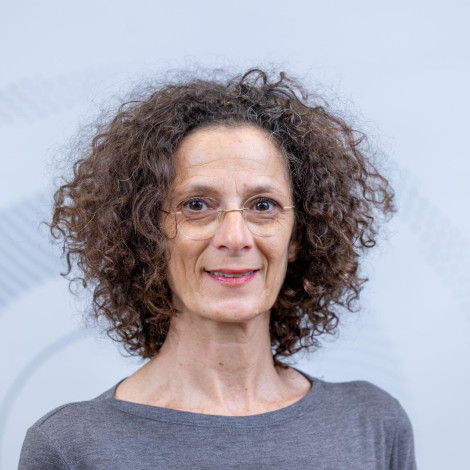
ד"ר אסתר הבר
קורות חיים
השכלה שם האוניברסיטה מחלקה שנת קבלת התואר
|
תואר ראשון |
אוניברסיטת בר-אילן |
לשון עברית ולשונות שמיות |
1997 |
|
תואר שני |
אוניברסיטת בר-אילן |
לשון עברית ולשונות שמיות |
2000 |
|
תואר שלישי |
אוניברסיטת בר-אילן |
לשון עברית ולשונות שמיות |
2005 |
נושא עבודת המוסמך: סוגיות לשוניות בלשון מקרא לאור תעודות אל-עמארנה
שם המנחה: פרופ' דניאל סיון
נושא עבודת הדוקטורט: הסמיכות המהופכת בלשון השומרית
שם המנחה: פרופ' יעקב קליין
מלגות ופרסים:
|
1997 |
מצטיינת דיקן לתואר הראשון, אוניברסיטת בר-אילן |
|
2000 |
פרס הרקטור למוסמכים מצטיינים, אוניברסיטת בר-אילן |
|
2001 - 2005 |
מלגת נשיא לדוקטורנטים מצטיינים, אוניברסיטת בר-אילן |
ניסיון מקצועי אחר (תפקידים ציבוריים):
|
2007 |
מרכזת תכנית להכשרת מורים ללימודי עברית כשפה שנייה – המחלקה להבעה עברית, אוניברסיטת בר-אילן |
|
2008 |
מזכירת האגודה הישראלית לאשורולוגיה ולחקר המזרח הקדום, ישראל |
|
2010 - 2013 |
מקימה את אתר המחלקה ללשון העברית וללשונות שמיות, אוניברסיטת בר-אילן ומפעילה אותו |
|
2014 - 2017 |
חוקרת במילון ההיסטורי, האקדמיה ללשון העברית, ירושלים |
|
2019 - 2020 |
מנהלת המרכז ללימודי העברית אוניברסיטת תל אביב, תל-אביב |
מחקר
פילולוגיה, המורפולוגיה והתחביר של לשון המקרא, מגילות מדבר יהודה ולשון חז"ל; תולדות הלשון; בלשנות שמית משווה
קורסים
הבעה - כתיבה אקדמית
הבעה עברית לתלמידי חו"ל
טקסטים מקראיים
יסודות התחביר למתמחים
מכינה למתקדמים ב'
סגנונות בלשון מקרא
עריכה טקסטים מדעיים
תחביר העברית החדשה (ללא מתמחים)
פירסומים
1. Esther Haber, "The Stylistic Role of the Anticipatory Genitive Construction in Sumerian Literature", Nouvelles Revue d'Assyriologie et d'Archéologie Orientale 103 (2009), pp. 37–48.
https://hebrew.biu.ac.il/files/hebrew/shared/haber_v.3_2.pdf
2. Esther Haber, "Significance of the Interchanging of the Mono-Consonantal Prepositions in Biblical Hebrew: Rabbinic and Comparative Semitic Evidence", MAARAV, A Journal for the Study of the Northwest Semitic Languages and Literatures 16 (2009), pp. 29–37.
3. Esther Haber, "The Double Genitive Construction in Akkadian Literatur", Nouvelles Assyriologiques Br èves et Utilitaires (N.A.B.U) 42 (2013), pp. 73–74.
4. Esther Haber, "Unbound Genitive Constructions and Double Genitive Constructions in Mishnaic Hebrew", Lešonenu 75 (2013), pp. 387 - 403. (HEB)
https://www.nli.org.il/en/articles/RAMBI000546163/NLI
5. Esther Haber, "A Complete Root Glossary of Canaanite Words and Forms from the Amarna Tablets", Šnaton: An Annual for Biblical and Near Eastern Studies 23 (2014), pp. 93 - 124. (HEB)
6. Esther Haber & Alexey Yuditsky, "The Phrase בין הגבולים in the 'Commentary on Genesis C' (4Q254)", Lešonenu 78 (2016), pp. 168 - 177. (HEB)
7. Esther Haber & Alexey Yuditsky, "4QCommentary on Genesis Scrolls: Notes on their Reading and Text", Megilot 13 (2017) pp. 71 - 85. (HEB)
https://www.academia.edu/35069440/4QCommentary_on_Genesis_Scrolls_Notes_on_their_Reading_and_Text
8. Esther Haber, "The Pesher Units in the Dead Sea Scrolls", Lešonenu 79 (2017), pp. 462 - 478. (HEB)
https://www.academia.edu/34909072/The_Pesher_Units_in_the_Dead_Sea_Scrolls
9. Esther Haber, "Coordination, Modern Hebrew", In G. Khan (Ed.), Encyclopedia of Hebrew Language and Linguistics (2013), pp. 620-621, Leiden: Brill.
https://hebrew.biu.ac.il/files/hebrew/shared/mshpt_mkhvbr_ntsyqlvpdyh_soff_0.pdf
10. Esther Haber, "Diachronic Explanations as a Method for Teaching Hebrew as a Second Language", Hedd Ha-Ulpan He-Hadash, 95 (2009), pp. 22-26. (HEB)
https://meyda.education.gov.il/files/AdultEducation/hed_haulpan/hed_22_95_ester_haber.pdf
|
International and local Conferences - Held in Israel |
|||
|
The Anticipatory Genitive Construction in Sumerian Language (HEB)
|
University of Haifa, Haifa |
The 6th Annual Conference of the Israel Society for Assyriology and Ancient Near Eastern Studies |
2006 |
|
The Advantage of diachronic Methods in a classroom of Hebrew as a second language (HEB) |
Bar-Ilan University, Ramat-Gan
|
A conference of Hebrew Language Teachers of a Second Language
|
2007 |
|
The Stylistic Role of the Anticipatory Genitive Construction in Sumerian Literature |
Würzburg, Germany |
The 54e Rencontre Assyriologique Internationale
|
2008 |
|
Significance of the Interchanging of the Mono-Consonantal Prepositions in Biblical Hebrew (HEB) |
The Hebrew University of Jerusalem, Jerusalem
|
The 15th World Congress of Jewish Studies
|
2009 |
|
Diachronic Explanations as a Method for Teaching Hebrew as a Second Language (HEB) |
Tel Aviv University, Tel Aviv
|
AILA - International Association of Applied Linguistics
|
2009 |
|
History and Methods for Teaching Hebrew as a Second Language (HEB) |
Mofet Institute, Tel Aviv |
Mofet Institute |
2010 |
|
The Stylistic Role of the Double Genitive Construction in Hebrew Language (HEB) |
Achva Academic College, Be'er Tuvia
|
AILA - International Association of Applied Linguistics
|
2012 |
|
Unbound Genitive Constructions and Double Genitive Construction in the Mishnah (HEB) |
Bar-Ilan University, Ramat-Gan
|
Department of Hebrew Language |
2013 |
|
A Court of So-and-So and the Court of Raban Gamliel's: Unbound Genitive Constructions and Double Genitive Construction in the Mishnah (HEB) |
The Hebrew University of Jerusalem, Jerusalem
|
The 16th World Congress of Jewish Studies
|
2013 |
|
Between Morphology and Style: Three Genitive Constructions in Northwest Semitic Languages |
The Hebrew University of Jerusalem, Jerusalem
|
Department of Hebrew Language |
2014 |
|
A Complete Root Glossary of Canaanite Words and Forms from the Amarna Tablets (HEB) |
Bar-Ilan University, Ramat-Gan
|
Department of Hebrew Language |
2014 |
|
The Pesher Units in the Dead Sea Scrolls (HEB)
|
The Israel Academy of Sciences and Humanities, Jerusalem
|
The Eighth International Symposium on the Hebrew of the Dead Sea Scrolls, Ben Sira, and Related Fields, New Aspects of the Texts and Language of the Dead Sea Scrolls Research Workshop of the Israel Science Foundation The Academy of the Hebrew Language |
2016 |
אמצעי התקשורת
תאריך עדכון אחרון : 10/04/2024



